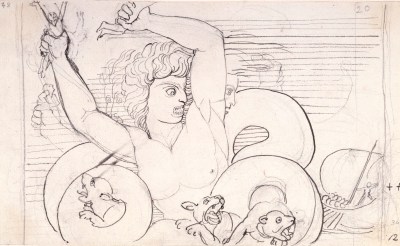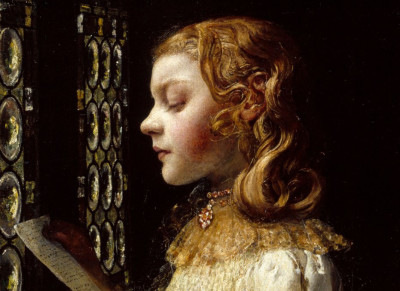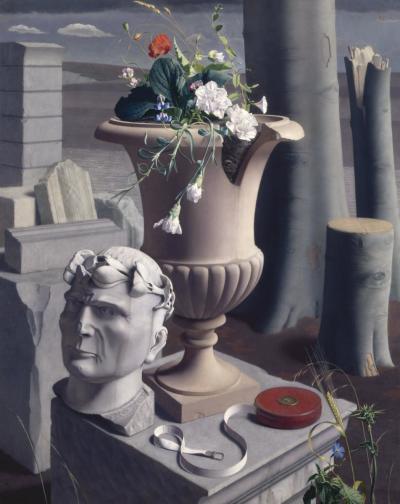How to read it: Gabriella Boyd’s “Sunhead”
How to read it: Gabriella Boyd’s “Sunhead”
By Helen Record
Published 13 August 2019
In Gabriella Boyd’s “Sunhead”, familiar shapes are given a surreal twist. The painting floats on the edge of reality where nothing is certain. But what does it mean? Where did the head go? And why is this painting in the RA’s Collection anyway?
-
This is the stuff of dreams…
Gabriella Boyd’s works feel like being in a dream. They present visions of recognisable objects and scenarios captured through a lens of haziness, just outside reality. The fragments of worlds that Boyd creates on her canvas are experiential rather than tangible, strange and familiar all at once. Looking at them gives a similar sensation to being in a dream, inhabiting a space just beyond the realm of reason, driven by atmosphere and memory rather than definitive truth.
“My paintings flit and bleed between the depiction of space and the physical experience of it”, she explains.
Across her work Boyd seeks to evoke a believable sensation that everyone can relate to. The figures are not specific individuals, the environments not particular places, and the forms are often ambiguous. Her paintings are accessible and flexible, giving an outline of reality that viewers can fill with their own understanding. In her words, “I like the idea of the viewer having their own freedom within the work, making their own journey through it.”
-

Gabriella Boyd, Sunhead, 2017.
Part of the RA CollectionOil on canvas. 1600 mm x 1200 mm. © The Artist. © Photo: Royal Academy of Arts, London. Photographer: Prudence Cuming Associates.
-
Not sure what’s going on? That’s sort of the point
In Sunhead, nothing is certain. Almost every part of this painting is open to interpretation, and this is very much Boyd’s intention. There are all sorts of ambiguities: the bottle-shaped torso could have medical and anatomical connotations or it could be vaguely erotic with its naked form and flesh-coloured tones. The head might have been chopped off, or it may merely be see-through, apparently replaced by a sun on the horizon. The lines snaking across the foreground might be a stethoscope, or some internal bodily organ, or a sprouting plant frond.
Boyd isn’t interested in dictating one particular reading – she likes the possibility of the shapes meaning different things to different people, all at the same time. Hers is a visual language that straddles many potential narratives. Even the title Sunhead doesn’t necessarily dictate what we see: Boyd welcomes the fact that some people might see the glowing yellow orb as the sun, or a halo, or even an egg yolk.
-
-

People, people, everywhere
Boyd’s artistic practice is saturated with the human experience. There are people – or parts of people – in almost all her paintings. Yet her figures aren’t specific individuals. The human figure is a device to (literally) embody the non-verbal connection between people. Boyd finds inspiration through memories of encounters with the full range of characters in her life – from family to strangers. This “peripheral awareness” of the rumblings of human interaction, monumental or unnoticed, is the blood that courses through Boyd’s creative spirit.
-
-
Boyd’s painting are environmentally-conscious… but not necessarily green
Boyd’s concern for the psychological impact of the environments we inhabit leads her to observe people in particular surroundings such as public transport or the confines of the home. Musing on how our physical situation shapes us and our behaviour, Boyd makes paintings that shine a light on the interweaving existence of personhood and place.
The line between human and environment is often blurred – as in Sunhead. The flatness of the painting, without definite sense of depth, brings the figure, horizon and sun close to each other, combining different layers into one. In another of her paintings, Pitch (2018), Boyd fuses human and environment so the interior of the room takes on anatomical properties. The yellow walls are a nauseating yellow and the central white orb acts as an unblinking eye.
-

Gabriella Boyd, Tomorrow Started, 2018.
©Gabriella Boyd.
-
Size matters…
Sunhead is big. Boyd works on canvases of all sizes, and their scale is intrinsically woven into the meaning of the painting. A larger canvas, like this one, allows wide participation and involvement with the work, inviting viewers to insert their own feelings and memories. A smaller painting, by contrast, might give a more intimate experience. The variation in size between Boyd’s paintings encourages the viewer to become aware of their own body and sense of scale in relation to the works and the figures within.
-
-
…but the painting is a bit of a squeeze
Despite its size, Sunhead feels strangely claustrophobic. The torso is pressed against the front of the canvas, foregrounded with such immediacy that it might just break free and enter our world. The outer edges of the canvas squeeze inwards on the figure’s arms, lodging the torso within the limits of the canvas. The contrast between this and the expansiveness of the horizon increases awareness of our physical surroundings, giving the sense of being too close and at a distance all at once.
The decisive use of the spatial limits of the canvas recurs throughout Boyd’s work. Paintings like Tomorrow Started (2018), Creep (2016) and Flood (2015) have edges that splice the figures, removing any sense of narrative and giving the impression of movement, of continuation, of a reality glimpsed and gone. As well as making the viewer feel their own presence in their environment, this harsh cropping adds to the ambiguity of the works, hinting at a world beyond the canvas.

-
-
-

And Sunhead is part of the RA’s Collection because…
Boyd created Sunhead as part of her final year degree show while studying at the RA Schools. This painting was selected for the Collection by the then Keeper, Eileen Cooper RA (who was in charge of the RA Schools), from all the artworks produced by the students in that year. This is called the Keeper’s Purchase Prize and is awarded each year to one of the graduating final year students.
-
-
You can see Sunhead as part of The Garden, in the Weston Studio at the RA. This free display celebrates 250 years of the RA Schools and features works by former students and their top picks from the Collection.
Gabriella Boyd lives and works in London.








